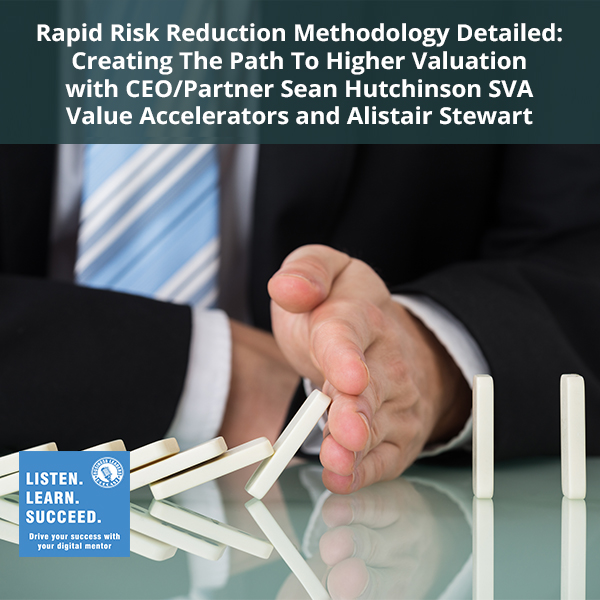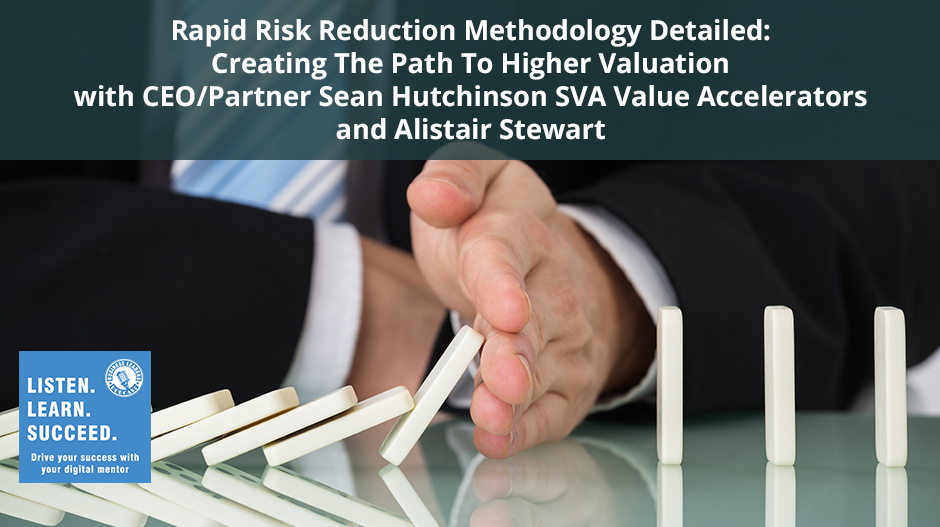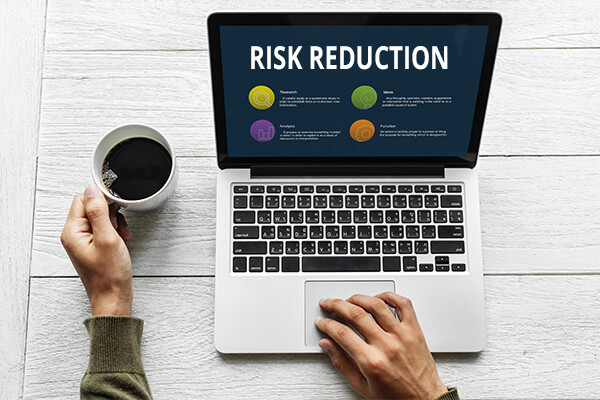Rapid Risk Reduction Methodology Detailed: Creating The Path To Higher Valuation with CEO/Partner Sean Hutchinson SVA Value Accelerators and Alistair Stewart


When we say higher valuation, many business owners focus more on profits than actually looking into the threats to earning those profits. Sean Hutchinson and Alistair Stewart of SVA Value Accelerators talk about the importance of risk reduction. Together, they lay down the five categories of risks out there for business owners to consider: strategic, compliance, operational, financial, and reputational risk. They present situations and solutions that could help you picture out how to overcome them. They also talk about whether owners are aware of these risks while discussing a de-risked company versus a risky company and the value gap between them.
—
Rapid Risk Reduction Methodology Detailed: Creating The Path To Higher Valuation with CEO/Partner Sean Hutchinson SVA Value Accelerators and Alistair Stewart
Creating The Path To Higher Valuation with CEO/Partner Sean Hutchinson
Risks are the consequences of an action, an event that is reasonably likely to undermine or threaten goals or objectives that have been determined. There are things you can do or stop doing to increase enterprise value that are counter-intuitive and will increase the value of your business.
We’re doing a deep dive continuation with Sean Hutchinson, CEO, and Partner with SVA Value Accelerators and Alistair Stewart. He’s the Manufacturing Practice Leader from SVA Value Accelerators. We’re going to dig deeper and we’re going to talk about rapid risk reduction. Alistair, let us know.
Risks are out there in a variety of categories and most business owners and people working in the business become a little desensitized to them. You can think of risks as being in a broad spectrum of categories. Strategic risk, compliance risk, operational risk, financial risk, and reputational risk. Those are five broad categories. We can also consider that risks exist within a business and risks exist outside of a business. If we look at how businesses are valued. If we look at the worth of a business, it’s pretty obvious to financial investors and pretty opaque to owners and employees that reducing risk represents a tremendous opportunity to increase the value of a business, particularly the transferable value of a business.
We can look at say strategic risk. Strategic risk is something that threatens the outcomes that a business has chosen to pursue. There’s a little bit of an eye-opener there. Are we choosing our outcomes? Do we understand the threats that compromise our ability to realize those outcomes? What might those risks, those threats be? We can go down the list of compliance if that matters to the industry that you’re in, operational, financial and reputational. A fairly straightforward discussion on those topics will reveal a tremendous amount of business value, of enterprise value, that’s threatened by inattention to these existential matters.
In these three categories of how to increase the value of the business, increasing earnings, reducing risk and increasing marketability, those broad categories, a lot of business owners and their teams are going to focus on increasing earnings as an instinctual way to increase the value of a business. That’s understandable. That’s where a lot of resources go. When we see that big category of things that you have to do to reduce risk or should do, could do or will do, less attention is typically paid to those things. They can have a dramatic effect immediately on the economic enterprise value, transferable enterprise value, and we can add value. What people need to realize, what owners might tune in on here, is that we can add value to our business pretty dramatically without adding $1 of revenue or $1 of profit. Those things in the beginning of the value acceleration process have less effect on value. In fact, they may counter-intuitively lessen the value of a business depending on how the dollars are earned. This is about the quality of the revenue and the quality of profit.
It’s not uncommon that an existential threat to a small business is undue or overreliance on owner or owners. It could mean, for example, that the owner of the business has critical customer relationships from which the majority of revenue or profits are derived. It could also mean that the owner of the business maintains the most critical supplier relationships. Both of these are areas for risk. Let’s look at customers. For example, you could have a key customer relationship is owned exclusively by the owner. It generates some profits. Perhaps not the best profits, perhaps by inattention acceptable profits and it’s all about the owner’s relationship with that customer. We think about transferable enterprise value, we think about risk in that relationship. If that owner transfers the relationship to the organization, transfers it from the individual to the organization, we now have a whole bunch of people who are capable of managing that customer relationship.
I have a real-world example. I’m working with a client now to de-risk. They had 40% of their business with one critical customer, who is price sensitive. There was a belief that the benefits of volume outweighed the sins of price concessions. The customer came back and said, “We like you so much. We’d like to give you more business.” The owner invested a non-trivial amount of time, personal energy and resources into winning price-conceded extra volume where we have 60% of the revenue and 52% of the profit coming from one customer. The entire relationship is exclusively owned by the business owner. That’s a tremendous risk to enterprise value.
There is often a tendency for relationships to forgive performance. We’d like to see performance measured in terms of delivery, quality, and cost. An objective team is going to look at that. Perhaps an owner who feels a personal connection to the supplier may not be focused on those kinds of metrics and will forgive performance sins. We move on not understanding that the inattention to those matters continues to increase the risks to enterprise value. Both of those factors from the supplier end and on the customer end are related to undue reliance on the owner. They have nothing to do with the organization’s focus on driving growth or if we’re going to market, putting together a book to tell the story about the company.
Alistair, do you think that the owners are aware of these risks?
They are unaware because it’s business as usual. I think of this as driving at 32 miles an hour in a 25-mile-an-hour speed zone. They’ve become accustomed to it and it’s habitual. Unless and until we have a conversation about transferable value do they become sensitized to the risky behaviors that they’ve habituated over probably decades. The one that is most interesting of the five risk categories is this idea of strategic risk. Strategy in business is a plan to capture, create and sustain value. Without that plan which many small business owners don’t have and the few that have a strategy often fail to execute the strategy. When you think of strategy in terms of their risks, which threaten those outcomes, we’re now starting to have a meaningful conversation. How will we understand that risk?
There are two elements to any risk that an owner needs to understand deeply. What is the potential impact to value and what is the likelihood of that impact to occur? When we start the conversation about the impact and the likelihood, we’re starting to think differently about enterprise value and what threatens enterprise value, particularly the transferability. It’s not unless and until we understand that enterprise value is significantly threatened that we have these meaningful conversations. If we’re not thinking about enterprise value, if we’re thinking about the business as just an ATM to the owner or an enabler of lifestyle or business as usual, then we’re probably not moving in the right direction. We move in the direction of our conversations. A conversation about risk is a very valuable conversation for business owners and their management teams to have and to continue to have.
There are four things that I would emphasize. One, there’s this concept of whale hunting in the sales and business development process. You talk about going out and getting the big customer that’s going to be the game changer. The instruction to that team is to find the customer that’s going to immediately double our revenues. There are a couple of things that are likely to happen in that process. One, the customer concentration problem. Maybe we’re already doing business with that customer and they wanted to expand it. They went from a comfortable 10% of revenues with one customer to 45% or 50% of revenues from one customer. The sales teams are excited because they did exactly what they were asked to do. They went out and they found a big customer. They expanded an important strategic relationship, but they created customer concentration. The chances are good that the transferable value of the company fell. In some cases, the company became non-transferable as a result of that.
 Risk Reduction: If we’re thinking about the business as just an ATM to the owner, then we’re probably not moving in the right direction.
Risk Reduction: If we’re thinking about the business as just an ATM to the owner, then we’re probably not moving in the right direction.
The owner reliance issue, the owner may own that relationship. They may have been involved in the whale hunting. They may have been a key and they will continue to be key. The customer is doing business with the business but also business with the owner. If that’s the case and the relationship is not distributed in the organization, again, the value has fallen. They get a double whammy there. The third thing that’s happening in that relationship is smaller businesses typically do not have what Michael Porter would call pricing power in the marketplace. They’re doing business with a bigger company. They’re not going to drive the price. In order to get that bigger deal, they may have to discount. Discounting is a very dangerous execution in terms of risk management.
The sales team goes out and says, “If we knocked 10% off that deal or 15% off that deal, we can get it.” The top line is going to increase. The gross margins are going to go down. The net margin is going to go down. We want the owner to flip and look at their business through the eyes of an investor. That deal became much less attractive. We might have a better top line, but we got the worse bottom line. We might have better topline, but we’ve got all these risks. Any investor is going to say, “I like the financial profile of the business or some things about it, but what’s going to get in the way of me realizing that potential?” The risks are what they’re going to pay attention to. The fourth thing that I would point to is not every risk is an important enough to focus on.Think about impact and likelihood. You can score both of them and get a sense of the total risk
We can evaluate the likelihood and the severity perhaps on a five-point scale then we do some math. When you multiply them together, it’sup to the owner, advisory team, their management team to decide what calculation represents something that merits management. There will always be risks that we can’t manage. When we do that math we can say, “These are the risks, the likelihood and the impact of which exceeded an acceptable threshold. We’re going to start to manage that risk.” That means identifying how we control that risk, how we monitor that risk.As an example, customer concentration. You can go into your CRM system and you could evaluate customers by profit dollars and look at who is the primary owner of the relationship with those accounts, with those clients, for example.
Once we establish a monitoring method for the risk, then we get it into saying, “Who is going to monitor the risk?” We’ve got a monitoring method. It’s who in our CRM system is making all the updates on the relationship, conversations, interactions, contracts, proposals, business, and fulfillment. We can monitor that, but who is going to do that? Who on a monthly basis is going to provide a client relationship report of interactions by a person within the organization, within the management team? We can establish a limit. We could say, “We don’t want any more than 30% of our A customers managed by the owner.” Right now we’re at 87%. That is a 57% opportunity to reduce undue reliance of the owner of key customer revenue and profit contribution. We can set a limit. In that case, I set a number of discussions with the advisory team, the management team and then what do we do? What actions do we put in place when we have an out of control condition? That could be in the next 60 days no “A customer” interaction will occur without the introduction of one or two others from the company’s team. It could be the straight sales leader on the supply side.
It could be the purchasing manager. It could be the person responsible for a value stream if the company sufficiently matured on its operational excellence journey to understand value streams. We also need to identify what actions are needed and what timeframe we’ll have to put those actions in place. It is a fairly straightforward process of understanding the impact, the probability, and the acceptable or unacceptable risk levels. What existing controls we have in place. How e will we monitor existential threats to enterprise value that the math of impact and probability represent? Who is going to be responsible at a monitoring level, because now we’re monitoring metrics? What’s our limit? What’s our action plan for out of control risks that exceed the limit? This is not intellectually challenging. It requires a constant conversation about risks to value and a focus on de-risking the organization.
Sean, you’ve got anything to add?
The accountability for managing risk, the dynamic nature of risk, is not static. It can be not risky one quarter and then upon reassessment in quarter number two, it could be a completely different story. Sometimes, external risks are out of your control, but you still need to be aware of them. Internal, more in your control, but still need to be aware and vigilant. That vigilance and that bias for action around risk management are important. It’s not about creating a scorecard, that’s a fantastic part of the process. Let’s identify and track it. Not all risks matter as much. Manage the metrics that matter the most. That’s what we refer to sometimes as big rocks versus little rocks.
You want to be putting your resources as a company towards big, impactful, likely risks which we would call the big rocks or existential risk. The things that if they were to emerge or remain present in the organization over a longer period of time could put it out of business. That’s the existential piece of this. Those are big rocks. The management team and the strategy and the execution of the company have to be aware of that and attack it with the right resources at the right time. If you spend all of your time pummeling away with your hammer at the tiny rocks, you can bash these things into fine gravel all day long.
Risks are the consequences of an action or an event that is reasonably likely to undermine or threaten goals that have been determined.
But if the big rocks are still there then your value drivers, the things that are driving value in your company, are facing such headwinds that you can’t get the boulder up the mountain. If you do get the boulder up the mountain like Sisyphus, it might roll back down. Now you’re in that spiral we were managing, but we didn’t act effectively enough to get the big impact risks out of the organization and keep them out of the organization. That’s the first part of the value maturity cycle.. You identify value drivers, and then you defend value by de-risking. Once you have minimized those things, you’ve got to set up a boundary that keeps them out. That’s what’s difficult. That vigilance is that boundary. It’s a way of monitoring and keeping that risk out of the organization.
I wanted to make sure that I didn’t forget to say for the folks that are going like, “That sounds like my company. I need to talk to these guys.” What are the ways to reach out to you guys via social media?
LinkedIn is a great way to get to us. We’re active on LinkedIn. I have a page, Sean P Hutchinson is my LinkedIn identity. Alistair Stewart has a LinkedIn page as well. The company page is SVA Value Accelerators. You can reach out to us in any of that channel. Certainly, our website BuildValueToday.com is a good way to reach us.
I’m the business owner reading and going like, “That sounds like me. I want to go down the road of starting this process.” What should I expect when you guys walk through the door or engage? What are the first things that occur?
 Risk Reduction: Not all risks matter as much. Manage the metrics that matter the most.
Risk Reduction: Not all risks matter as much. Manage the metrics that matter the most.
What we call discovery. We’re going to sit down with all of our clients in the beginning and try to get a baseline on the company. We’re going to get a baseline on probably eight to ten different dimensions in the company that range from their ability to develop good strategy, execute good strategy, and identify and enhance operational value drivers and mitigate and defend against value killers. We’re going to rank those things. The most valuable part of the conversation with owners and management teams is the conversation itself. We can capture data and we can put red, yellow and green on it all day long. In the conversations, we capture what we call enriched data. Enriched data is where the real story is. Being able to interview clients’ face-to-face, interview other stakeholders in the organization gives us a good picture of what’s going on. We’re going to talk about what do we do in order to address all those things that are underperforming in an organization, things that are not creating transferable enterprise value. Right up front, we’ll start addressing risk. Rapid risk reduction is one of our early value acceleration sprints. What we’re going to do in discovery is to identify value in the organization, identify things that are killing and driving value opportunities. We’re going to look at it holistically. Think of defense as an immune system in the company so it can identify risk and reject it as soon as possible. Everything after that is an upswing of value because we’ve created that platform on which value opportunity can be built and captured. Existential risks in an organization are basically like standing on a burning platform. If you try to build on that then good luck because it’s going to burn up and you’re going to fall.
There’s good news for owners and their management teams and the entire workforce in these conversations about risk. We are asking owners and their management teams to work differently and in many cases, this can be considered as a set of rewarding advantages. Instead of constantly chasing B customers, for example, and spending tons of engineering and delivery resources on business that is just okay revenue and negative profit, how about if we manage risks and work 45 hours a week or 50 hours a week instead of increasing risks by working hard for 60 hours a week? It puts the organization in a more secure position. It increases the work satisfaction for the management team.
It seems to me that this process is going to happen one of two ways. Either the owners going to drive it or the potential acquirer is going to identify it. One of the two things is going to happen and eventually, the data is going to come out either way.
It comes out in diligence. You can have a number in the letter of intent and 30 days later after some diligence, that number could be halved. I’m working with a client who’s looking at a 55% decline from the number in the LOI to the post-diligence number. A significant majority of the reduction is due to the enterprise risk that the owner had become complacent about over a number of years. Effective diligence could open up the gap between price and value. As everybody who’s done research on transaction failure will understand, a leading cause of transaction failure is the gap between price and perceived value.
What was the reaction of that owner?
Tremendous unhappiness. Potentially, that owner has to sacrifice a couple of years of his life to get to the risk-reduced number that’s acceptable to both parties in the transaction. He’s probably not going to sell to this buyer. He’s going to have to spend probably a good 24 months de-risking to get to the number that he wants. I’m pretty confident that if we’d started rapid risk reduction a couple of years ago, the LOI number itself would have been higher and wouldn’t have been very much reduced. We’re in catch-up mode and unfortunately, busted deals are rarely unknown in the industry so that will affect future efforts.
Doing all this stuff sounds like, “I’ve got to go get a booster shot or something bad or a root canal,” but the reality is risk reduction is good business practices.
At the highest level, transition readiness is “good business.” If we recognize that rapid risk reduction is an early element of increasing your transition readiness. It’s good business, earlier.
When you work with a small business owner and they’re talking about getting ready, what’s the typical first or second behavior that you see them engage in when they’re trying to get their company ready for sale before you guys get involved? What do they typically do?
They try to dress up the financial performance of the organization. I’ll tell you a story that comes secondhand from a trusted source. The owner drives growth for a long time and then knows that the management team doesn’t know yet, but the CFO does, that he is preparing to sell the company. He’s got a two to three-year plan. He starts taking money out of growth and putting it in profit. He said, “We’re not driving growth anymore. We’re driving profit margin.” That’s good. I don’t mind that. A more profitable smaller company is better than a bigger less profitable company. A lot of people drive the top line. The assumption is we’re going to grow our way out of margin or other risks that are happening.
Shrinking the size of a company in order to be more profitable on the financial side can be not only counterintuitive but uncomfortable. If you think about it in the terms of a community, how do you explain–once the word is out because people know it — how do you explain that your company revenues are shrinking? It could be interpreted that the company is failing when in fact the owners are making moves to make it more profitable. That’s okay. Most of the time, the primary focus is on the financial profile of the company prior to taking it to market, rather than reducing the risk in order to capture additional value that may be hidden in the business. If you’re paid a multiple on risk management, that exceeds, in most cases, the multiple that you would get for financial performance. It’s valued more in the marketplace by an investor. A low-risk business will be valued more than gaining a few points on your profit margin.
 Risk Reduction: The reality is risk reduction is a good business practice.
Risk Reduction: The reality is risk reduction is a good business practice.
The first conversation is, “What’s my business worth?” I don’t know much about manufacturing and I know almost nothing about everything else, but my decades of experience in manufacturing have led me to these observations. Business owners seethe value of the business as the multiple established in the market times EBITDA, “earnings before interest, taxes, depreciation, and amortization.” One can think of EBITDA being a proxy for free cash flow. It’s not identical, but they’re kissing cousins. Most owners that I work with believe that EBITDA is a lever and the multiple is not something that they can influence.
The element of the multiple that is most significant is company-specific risk and every EBITDA dollar is multiplied by whatever that represents. Let’s say that the multiple is four, which means the risk-adjusted cost of capital is 25%. The current cost of debt is around 5%. A little bit of size and liquidity penalty might get you to 12% or 13%. That leaves 12% or 13%, fully 50% of the risk adjusted cost of capital in this example, represented by company-specific risk. I don’t know if you need more customers, more top line. I do know that you need to manage and reduce company-specific risks because every profit dollar gets multiplied by whatever that is.
I’ll tell you one of my pet peeves. I hate the phrase, “My company is worth what the buyer will pay for it.” I hate it because it’s completely untrue. It demotivates an owner and their team from being an active participant in the creation of value. If your company is worth what the market will pay for it, why try? When you think of the market, the market is going to tell you what they’re willing to pay for it. It might be low. It might be high. It depends on external conditions. You can influence the multiple. The biggest influence of the multiple is going to be the level of risk in your company. The more risk there is, the lower the multiple.
The jumps in the upside of multiple, exponential leaps up that ladder, are going to come not from adding dollars to the bottom line necessarily, but by reducing the risk in the organization. I know I’ve been hammering away on this. I feel I’m beating a horse, but this is such an important issue. What everybody needs to plug into is that you could be putting all of your resources into driving the wrong result. If you focus 100% on driving earnings in your organization, great. You should be focusing on earnings. If you ignore all this other stuff, you’ve missed the value opportunity. That’s where the exponential value opportunity is. Part of our job as Value Accelerators is to help our clients see it and manage it over time. We’re not going to tell people what to do. We don’t know as much as our clients know about their business and we never will. The skills that we do have are acting as a pair of eyes, a set of eyes that can see risk potentially more objectively in order to help the organization. It helps organizations solve it objectively for the right reasons.
There’s a real disconnect with what people see is worst in class average and best in class in the same industry group. Your discussion of a de-risked company versus a risky company and the value gap as best in class.
Sometimes it’s difficult to see in the numbers in what I would call quantitative benchmarks. We can go in and we can get benchmarks on a company in a particular industry, a particular size, and we can get those with some reliability depending on how big the industry is over a period of time. I can say, “My client has this much cash on hand and they’ve got this many receivables. Here’s their working capital and things like that. How does that compare to their peers in the industry during the same period?” We can get a few touch points on that. The qualitative stuff, the company-specific risk, is a harder area to benchmark because it’s not published. We talk about risk reduction, but are you doing risk reduction better than your peers? That’s difficult to determine. That’s part of the challenge of valuing or pricing a private business because you don’t know what you’re getting into until you lift the hood and get in there.
There is no transparency in the private marketplace. We can’t look at it like you look at a public company because there’s nothing published on it. Nobody’s going to put out an annual report. You can’t pick up enough data to compare to other companies. You have to judge it once you’re in there. Everybody is going to have their own objective standard on how much risk they’re willing to bear when they purchase or invest in a company. Let me make one other point. There’s another version of risk that people need to be aware of in situations where, as an example, they are transferring the company to the next generation in a family-owned business. In that case, we may not be talking about pricing or the value in the same way that we’re talking about it in the third-party investment market. In this particular case, the owner is highly motivated to transfer more value than risk to the next generation.
Owners need to know that they can add value to their business pretty dramatically without adding $1 of revenue and $1 of profit.
I can’t think of a parent, at least a healthy one, who would think about transferring a lot of risk to their children via the business. Why would they want to do that? Often, they’ll transfer earnings power through the financial performance of the business. Inherent in the business underlying that earnings power maybe some concessions or some moves that were made by the owner or management that constitute a lot of risks. Now, they’ve hung a rock around the next generation, who are going to have to deal with those things. Maybe they are kicked down the road. The can got kicked or they didn’t focus on risk management. I would rather inherit a business which is less risky and somewhat less profitable with greater earnings potential but a lower risk profile than I would a business that’s knocking it out of the park but has done all the things that are injecting risk into the business along the way. From an intergenerational standpoint, focusing on risk may be even more important because that risk now hangs around at the Thanksgiving dinner table. That’s not a pleasant experience as we can all imagine.
If you think of risks at the most fundamental level as threats to chosen outcomes, no parent says, “I want to make sure that my great-grandchildren leave college burdened with student loan debt.” A couple of things on early observations Bob made. You’re talking about best in class. You talked about the perils of victim thinking in that the market sets the price for my business. I’m working with a client where it’s a very frothy market. The business that he has been in is of significant interest to primarily financial investors who have too much money and too few good choices about where to put it to use. Multiples in that niche are 6.75 times EBITDA. The potential acquirer came back with a price which represents a 2.75 multiple. The gap is exclusively company-specific risks, the invisibility of the risks and even when they became visible, the lack of clarity in understanding the risks. First of all, my client didn’t know they were there. Once he knew they were there, they weren’t fully formed and he was looking at rocks out there in front of a ship in the middle and didn’t understand what he was seeing.
I do want to bring us back to one word in the topic of the webinar, which we might want to focus a little on and that’s rapid. We’re not asking people to work more. We’re not asking an owner to do 70 hours instead of 60 hours a week. We’re asking an owner to do 55 hours a week instead of 60 hours a week or 50 hours a week instead of 60 hours a week by identifying threats to a chosen outcome. Threats in five categories, strategic, compliance, operational, financial and reputational. Threats that could have their root causes inside the business or outside the business. Tariffs and trade policy are external threats. The health of a chain-smoking, hard-drinking production manager is inside the business. That’s an operational risk.
In very short order, perform the basics of identifying the risks. These are the discussions. We move in the direction of our conversations. When we talk about these things, we have something to put on paper. If it’s not written down, it doesn’t exist. Assess the impact on the business and the likelihood of that threat materializing. We go through and say, “What are acceptable risk levels? What are our existing controls? How are we going to monitor them? Who’s going to monitor them? What limit can we tolerate? Are we prepared to tolerate? What actions will we have for out of control conditions?” Which leads us into a bias for action. The actions, to which we are biased, reduce risk. Reduce the threats to our chosen outcomes. We perform those actions instead of winning yet another B customer.
It drives a sales effort. Sean, what are we missing in this component? I love this particular discussion. It’s concrete, identifiable, actionable and measurable.
 Risk Reduction: Move in the direction of your conversations.
Risk Reduction: Move in the direction of your conversations.
One of the nice things about this particular 90-day sprint in our Value Accelerator is that you do see immediate results. You’re not waiting a couple of years to figure out whether it worked. You’re seeing your company work better as a result right off the bat. You’ll see it also soon after, if not immediately, in the financial statements. You’ll see it reflected in the numbers. Those metrics that you’re going to figure out, you’re becoming a more self-aware company. It’s not the owner that’s supposed to be looking out for this stuff. Ultimately, if risk reduction becomes a part of your culture, it becomes part of the DNA of the company. Everybody is watching out for it. That’s what you have to have. It goes to the leadership model that we talked about in another podcast, the leader-leader model where everybody becomes a leader in risk management, in identifying and keeping risks out of the organization. They practice vigilance on their own, as a daily practice.
There is one important thing here: in the beginning companies need to be precise about the risks that they can see. You don’t want to be chasing everything. You want to be as precise and vigilant as you can. There are also risks that you probably think are too farfetched. How many soybean farmers out there would have thought, until it happened, that there would be such a tariff on soybeans? That 70% to 90% of their soybean crop that they were going to sell to China is now off the market? They’re done. They’re cooked during this period. I don’t think anybody that was monitoring risk out there would have said, “We might get a tariff that drives us out of business” because it wasn’t on the table. In Napa, close to where I used to live in San Francisco, you probably remember a few years ago those horrible fires came through the valley. The wineries in that area, the vineyards, were not prepared for that with the exception of a few that had significant fire suppression systems in place just in case. Nobody else out there thought to themselves that Napa Valley could to a large extent burn in a short period of time. Those fires were atomic bomb-level destruction.
You’ve got residual risk that comes out of that that nobody was prepared for. You can trap yourself into thinking, “That’s not a risk.” You can trap yourself into the likelihood piece, which is nobody would have thought the Napa fire with that much destructive power was going to be likely. That doesn’t mean that you don’t prepare for it. The vineyards that had fire suppression strategies in place survived pretty well when other vineyards lost everything. If you think of the vineyards, those are old growth vineyards in Napa Valley. They don’t get replanted and come back. That’s a special kind of grape growing there. It’s going to take generations to recover from that if ever.
When there’s an event that occurs that you’ve thought about it and you know what steps you’ll take when and if the event occurs. You know up front. If you see an event happen somewhere else on the planet and you go, “What would happen if it happened here?” Don’t sit there and do nothing. We did the same thing in Colorado where the big fire in the high country. I looked at it and go, “What would happen if we had a fire in our neighborhood?” A couple of years later, we had a fire in town and burned within 200 yards of my house. You guys have an exciting development coming the first part of 2019 that you’re rolling out a course.
We’re rolling out one online learning platform for all owners, not in the late stage Baby Boomer category where they’re preparing potentially for some ownership transition, but also younger business owners or even people who are thinking about getting into the business. It’s an educational resource and it’s also a place to meet other business owners. You can become part of a cohort learning together. To that end, we’re starting in a number of different markets around the United States, a high-level transition readiness program in what we call Mastermind Groups. These are groups of ten owners that work through value acceleration at a high level to create a transition roadmap for themselves over a one-year period. They’re going to get pieces of our full Value Accelerator. They’re going to build that roadmap with their peers and are going to prepare to execute it. This is one of the first times that our Value Accelerator has been delivered within this format. They will be face-to-face. They’re not done online right now. The first groups are going to be in the Chicago area. We’re also thinking about starting some of them in Montana as well. The City of Bozeman is interested in ensuring the continued economic vitality of that area. We hope to bring those programs here to the fastest growing small city in the state in the early part of 2019.
What struck me is many business owners don’t know what they don’t know. Most of them have not sold multiple businesses. Most of the business owners this is their first lap around the track in selling their business. I don’t think they’ve had a potential investor-buyer dig through their shorts to understand what they’re missing.
Starting early is definitely a hallmark of successful transitions at a higher value.
That’s true. Conducting preliminary due diligence on yourself, what we would call reverse due diligence, is an important part of that preparation. Be very eyes wide open about what’s going on in the company. Owners are smart about their business and they may see these risks, but they may not know how to prioritize them. Getting outside help can be powerful there.
Alistair, you got anything else to add to this module?
I encourage any owner who is looking at their business as a substantial piece of their personal net worth to start exploring how rapid risk reduction can rapidly increase their personal net worth. Contribute to other things that may motivate them as business owners including legacy and transferring it down the generations.
The biggest mistake an owner reading this could make is not reaching out. It doesn’t cost anything to reach out and ask.
We’re happy to get on the phone or have a Zoom call with folks to discuss their specific situation. We talk about the cost of doing nothing. Owners and their teams need to home in on that. What is, in fact, the cost of doing nothing here? It could be small in their opinion, but in most cases when we talk to business owners, the cost of doing nothing is high. In some cases, I’ve had them say it’s catastrophic. We have to go. We always help our clients take that first step. You can get frozen not knowing where to start. You become paralyzed. Our advice is always do one thing and that thing might be let’s do discovery on your business. Let’s find out what’s going on. Let’s get a second opinion in a sense. That’s a good place to start.
 Risk Reduction: Many business owners don’t know what they don’t know.
Risk Reduction: Many business owners don’t know what they don’t know.
For the folks that are out there going like, “I’m not planning on selling my business anytime soon.” My rejoinder to that is you don’t know. Reaching out in any phase of running your business to the assessment of where you are because if you have a divorce that comes through or disability or death of a partner. You’re going to figure it out pretty quickly at that point. What’s the typical timeframe to get ready for sale, about three years?
We do have triggering clients who want to do it in a short period of time, but you can only do so much in a shorter period. You’re going to lose some value as a result of that. Starting early is definitely a hallmark of successful transitions at a higher value.
Alistair?
I had one thing right. Heart disease is known as the silent killer and complacency, acceptance of unacknowledged invisible risks is a silent killer for any business owner and their business.
That’s an appropriate note to wind up this module. I appreciate you Sean and Alistair for your commentary and insights.
Our pleasure. Thank you, Bob.
Thank you, Bob.
Links Mentioned:
- SVA Value Accelerators
- Michael Porter
- SeanPHutchinson – LinkedIn
- Alistair Stewart – LinkedIn
- SVA Value Accelerators – LinkedIn
- http://BuildValueToday.com/
About Sean Hutchinson
 Over my 25+ years in business, the best lessons I’ve learned have been from business owners who have generously shared their stories of success and struggle and allowed me to offer insights and guidance based on my experiences.
Over my 25+ years in business, the best lessons I’ve learned have been from business owners who have generously shared their stories of success and struggle and allowed me to offer insights and guidance based on my experiences.
We share a bond. I’ve founded five companies, all of them with partners, some more successful than others. I’ve led a fast-growing global company as a very green, but hard-working and quick-learning, 34-year-old who every day had to make big decisions with big implications. It became the largest firm of its kind in the world. And, maybe most importantly, in this case, I’m the 3rd Generation heir to my family’s 60-year-old custom millwork manufacturing business. I’ve sat in the owner’s chair many times and I love being an entrepreneur.
As one of the three founders of SVA Value Accelerators, my role is once again to fulfill the responsibilities of the Chief Executive Officer. I focus mostly on strategy and growth – in other words, our Company of the Future. And that’s where I help our clients too – working with owners and their leadership teams to imagine what could be, can be, and will be their Company of the Future. I see my work as transformational, not transactional. Whether an ownership transition is near or on the far horizon, it’s all about getting owners “Ready for Next” by creating a constant state of Transition-Readiness.
About Alistair Stewart
 Family owned businesses are in my blood. My grandfather’s business gave his children a great start in life, and gave me early insights into what must go right. Much of my professional career has been spent helping the owners of small and medium size manufacturers clarify what success means, and achieve it.
Family owned businesses are in my blood. My grandfather’s business gave his children a great start in life, and gave me early insights into what must go right. Much of my professional career has been spent helping the owners of small and medium size manufacturers clarify what success means, and achieve it.
My parents wisely didn’t lead me into the business my grandfather started, and after graduating from Plymouth University (U.K.), I worked as an accountant in large corporations. This leads me to a position in the U.S., and then to the U.S. Dept. of Commerce’s Manufacturing Extension Partnership (MEP), with an intense focus on growth, profitability, and value creation for small and medium-size manufacturers
Many business owners contemplating the third stage of their lives have relied on me to clarify their motives, support their personal journeys to transition readiness, and increase business value.
I hold a Master of Science degree in Communication from Northwestern University, am a Certified Exit Planning Advisor, a Master Business Innovator, with additional professional credentials in Lean and Six Sigma. I served as a Senior Advisor at an Investment Banking firm, and I currently serve on the Advisory Board of a manufacturing business.
Love the show? Subscribe, rate, review, and share!
Join the Business Leaders Podcast Community today:
- businessleaderspodcast.com
- Business Leaders Facebook
- Business Leaders Twitter
- Business Leader LinkedIn
- Business Leaders YouTube
The post Rapid Risk Reduction Methodology Detailed: Creating The Path To Higher Valuation with CEO/Partner Sean Hutchinson SVA Value Accelerators and Alistair Stewart appeared first on My podcast website.